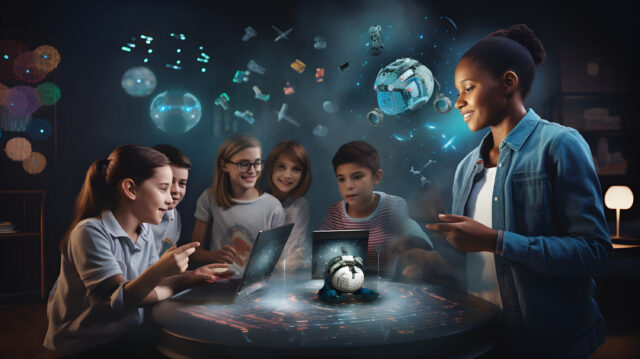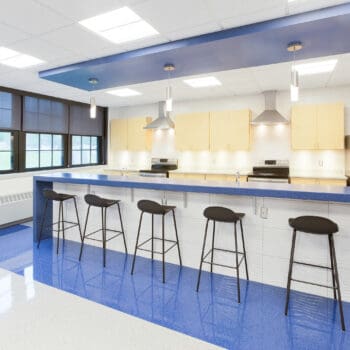Harnessing AI for the Future of Educational Design

The robots are coming! Many of us may feel that artificial intelligence (AI) is infiltrating our lives. AI has developed in such a way that it can be used to create, think, and design for us with the click of a button. With the concern that these robots will take over our ability to teach and create, how can we harness the power of AI to enhance and support the future of educational design, and generate more robust, well informed, and intentional design solutions for students?
The Role of AI in Education and Design
In February 2023, Stanford University held an education summit on AI and stated that “ChatGPT had reached more than 100 million unique users, and 30% of all college students had used it for assignments, making it one of the fastest-ever applications ever adopted overall – and certainly in education settings. Within the education world, teachers and school districts have been wrestling with how to respond to this emerging technology.”1 This summit set out to ask and hopefully answer, “How can AI like this and other applications be best used to advance human learning?”1
If we consider fundamental learning theories such as Maslow’s hierarchy of needs or Piaget’s stages of cognitive development, we see intrinsically linked basic principles on how children access information through their built environments. Some of these basic principles include the need to feel physically and emotionally safe, the need for engagement on a social and community level, and the importance of learning through hands-on experiences, all leading to self-actualization.
As designers, we seek to address these needs through spatial cues like appropriate scale, visual order, and flexibility in arrangements of furniture, providing choices such as individual areas of refuge or large gathering and collaborative environments for multimodal learning. We include elements of biophilia and indoor/outdoor spaces to integrate natural elements into our built environments and address inclusion and accessibility through best practices and code.
Let’s look again at the question at hand: how can we as designers harness AI to advance human learning and the educational environment? Programs like ChatGPT (a text generator) or Midjourney (an image generator) may be to able to support our efforts in programming and conceptual design. By using platforms like these to broaden our own understanding of how to address educational design, we can tap into a vast network of information and tools to promote efficiency and expansive thinking.
Leveraging AI for Design Efficiency
Let’s consider the knowledge base designers already carry. We know that it is imperative to holistic design to understand the fundamental needs of our clients, their districts, and their communities. Often, we can discover and examine these needs through touring the premises, talking with the stakeholders, holding design charettes, and administering end-user surveys. Real-time feedback and suggestions prompted by AI could support the development of end-user surveys to specifically target the individual needs of a district.
For example, typing a simple prompt such as “create an end-user survey for an elementary school media center” into ChatGPT could generate a letterhead and broad range survey containing questions like, “What types of materials and resources would you like to see available in the media center?” and “What atmosphere or ambiance would you like the media center to have (i.e., cozy, modern, vibrant, traditional)?” The survey, which was developed in mere seconds by an AI program, could function as an outline and starting point to drill down questions tailored to each client’s needs.
Additionally, this type of survey done on this platform has the potential to promote metrics and solutions for design implementation. As suggested in the aforementioned article, “Interfaces that leverage AI can offer constructive feedback that does not carry the same stakes or cause the same self-consciousness as a human’s response. Learners are therefore more willing to engage, take risks, and be vulnerable.”1 The learners here are our clients, and we are the educators looking to create comprehensive assessments of their districts and improvements they may not have considered.
Supporting Technology Integration in Educational Spaces
Knowing that children learn best in collaborative, hands-on environments, we can look to AI to support their learning through the inclusion of this technology while designing spaces that foster its use. We have already seen the introduction of virtual reality (VR) and augmented reality (AR) in the classrooms. In the design of makerspaces and STEAM labs, we support these technologies by integrating green screens, VR headsets, touchscreens, and 3D modeling software to enhance learning. Green screens in classrooms can allow students to create videos, announcements, presentations, and more by expanding the classroom to other worlds – both built and imagined. VR headsets can place students into simulated situations such as a visit to a museum in Paris or a prehistoric land, furthering their assimilation and connection to the curriculum.
These tools have become widely accepted as delivery methods for learning and speak to the native-technology user’s information gathering and communication style. Understanding these tools has enhanced the educational landscape, and we must look to the newest technologies in AI and consider their adoption and use.
For example, Midjourney is an AI program that can be used to develop artwork and generate images via a series of prompts. A tool like this could be used in the classroom to support creative writing, illustration, and presentations by providing students with a starting point for creative exploration in areas such as surrealism and fantasy. Additionally, this type of tool could provide equity for students with limitations in mobility. Imagine a student without the use of his or her hands being able to create a rendered image simply by using descriptive words via the speech-to-text capabilities of an AI program.
Tailoring Learning Environments for Diverse Needs
Lastly, let’s further consider how we can use AI to design for equitable spaces. We have discussed how AI in the classroom could support mobility limitations, but how can AI support cognitive limitations or different learning styles? Employing AI as a tool to measure skill and ability could support educators in developing learning tools that reach those individuals.
As a designer, AI could inform how we approach accessibility, wayfinding, and sensory stimulation. The infusion of AI into inclusive design could mean integrating digital assistants like Siri or Alexa to communicate more thoroughly. It could mean using text-to-image tools for signage and wayfinding in conjunction with traditional accessible signage such as Braille lettering or contrasting colors. It could mean exploring how AI supports sensory stimulation through imagery, light, and sound.
Couple any one of these ideas with flexibility and choice (e.g. a variety of seating, modular and movable furniture and partitions, access to outdoor environments, and areas of refuge) and you now have a learning environment that can be tailored to a variety of needs and learning styles.
Navigating the AI Landscape Responsibly
As designers, we are responsible for approaching the use of AI tools with care, respect, and caution. Our own critical thinking and ability to question the information being generated is paramount. As with any available information, we must do our own research and analysis to determine accuracy and verify content. Currently, GPT-4 has only been trained on data up to September 2021, so any information produced from this platform has the potential to be outdated. Therefore, due diligence is crucial.
Furthermore, as design firms, we must be proactive about developing policies regarding how these tools can be used responsibly. Timothy M. Webber, PE, Director of Civil Engineering at LaBella, has been exploring the use of these tools and developing protocols for referencing and sourcing the information gathered and generated by these programs. According to Webber, “We need to wrap our heads around these tools and quickly. We can’t know how good these tools truly are until we use them, but we must treat them with respect.”
Embracing AI as Designers of the Future
A recent article from Teneo.ai released a ranking of U.S. industries with the highest potential for AI automation. Architecture and engineering appeared third on the chart, coming in with a 37% estimated share of employment exposed to AI automation.2 Going forward, AI could reshape how we generate programming, design solutions, and even construction efficiencies. Therefore, it may be time to sign a peace treaty to end our internal battle against the “invasion” of AI.
As designers, we constantly seek to improve the lives of others through just, inclusive, and equitable environments. Technology integration in learning environments combined with the supportive tools of AI for design can supplement students’ need to learn from firsthand and authentic experiences, connecting those ideas and innovation to the real world. By cultivating this landscape of critical thinkers, innovators, and advocates through the responsible use of AI, we can seek to reshape not just our interior environments but our communities and beyond.
References
- https://hai.stanford.edu/news/ai-will-transform-teaching-and-learning-lets-get-it-right
- https://www.teneo.ai/blog/ai-automation-potential-us



About the Author
Courtney Ter-Velde, CID, ALEP, LEED GA, IIDASenior Interior Designer
Insights by Courtney Ter-Velde, CID, ALEP, LEED GA, IIDA:
As a NYS Certified Interior Designer, Courtney has over 10 years of experience in commercial interior design, with a focus in educational planning and K-12 design (Master Planning, CIP, COEP, and SED). Courtney’s expertise in educational and K-12 design includes programming, space planning, standardization, visualization, and the ability to customize and tailor each district’s needs through evidence-based design for social and emotional learning and student exploration. She is passionate about creating future-forward learning environments that stimulate students and educators alike.

